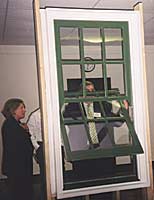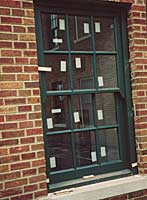|
The majority of the windows at the Motherhouse,
a religious residential facility in Monroe, Michigan,
renovated by Susan Maxman & Partners, were
wood double-hung windows with single glazed true
divided lights that were very energy inefficient.
In order to make an informed decision to either
refurbish or replace the windows, a number of
criteria were developed by which to evaluate the
alternatives.

|
 |
Windows
were restored, left, and replaced at
the Motherhouse by Susan Maxman &
Partners
Photos courtesy of Susan Maxman &
Partners |
|
Thermal performance of the windows was a given
and a key element in the Sister's goal of
sustainability. UV protection and glare were important
considerations for the failing eyesight of many
of the aging Sisters. The windows had to be easy
for the Sisters to operate and clean. The look
of the windows was one of the significant character
defining elements of the building and was important
to both the State Historic Preservation Office
and the Sisters.
Construction waste, manufacturing waste, and
energy spent in transportation were part of the
project's sustainable design goals. Other
client concerns included budget, energy efficiency
life, and expected life of windows selected over
available alternatives. Life cycle costs, however,
were not evaluated. Design criteria included the
following:
Thermal Performance:
- U-values in summer and winter
- Shading coefficient
- Air infiltration
Visual Health:
- UV transmittance
- Glare reduction
Function:
- Ease of operation
- Ease of cleaning
- Ease of installation
- Maintenance
Aesthetics:
- Historical accuracy
- State Historic Preservation Office Acceptance
- Sight lines
Sustainability:
- Waste material generated
- Manufacturing waste
- Green materials
Cost:
- First costs including screens
Window Life:
Alternative Options
Eight alternatives were developed and analyzed
during the design phase. A ninth was suggested
during the bid phase. A matrix was developed which
compared the seven alternatives to the criteria:
- Keeping the existing single-glazed windows
- Refurbishing the existing with a double-glazed
energy panel
- Refurbishing the existing with a low-E double-glazed
energy panel
- Refurbishing the existing with double-glazed
heat-mirror glass was not possible for the existing
windows.
- New aluminum clad wood windows with double-glazed
low-E glass
- New aluminum clad wood windows with double-glazed
heat-mirror glass
- New aluminum windows with double-glazed low-E
glass
- New aluminum windows with double-glazed heat-mirror
glass
- Refurbishing the existing frames and replacing
the sash with double-glazed low-E glass.
Analysis and Solution
In general, refurbishing the existing windows
with new double-glazed low-E glass ranked higher
in all categories. The project was bid with this
alternative. The bids for this alternative came
in higher than the estimate. One of the bidders,
however, proposed the idea of using double glazed
replacement sash with low-E glazing in the existing
frames. The cost was closer to the estimated price
for the alternative with the refurbished sash.
This solution met the Sister's combined goals
of sustainability and preservation and was accepted
pending approval of a mockup.
The existing windows in the cloisters were lowered
and the sash replaced with new steel windows.
What was once an inwardly focused residence has
been transformed into a new home for the Sisters
that is strongly connected to the outdoor environment.
Karin Tetlow is principal
of Restorative Partners and writes frequently
about design and construction.
|